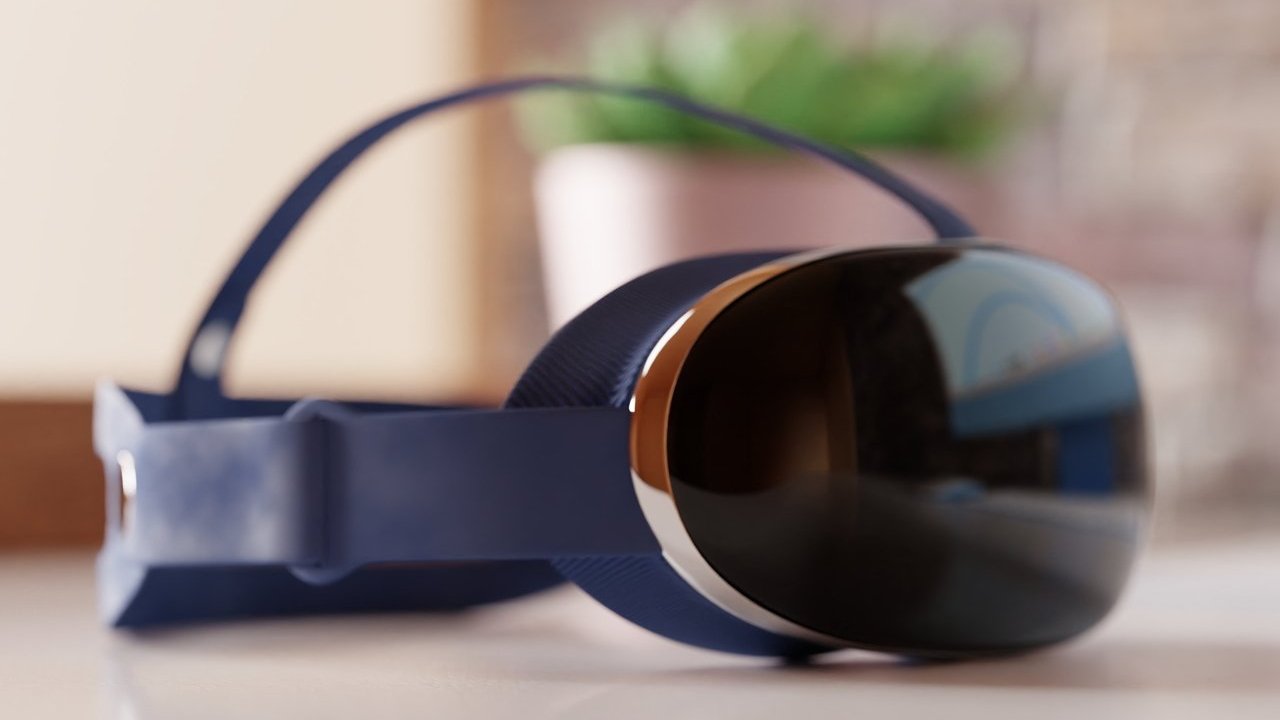Data about Apple's AR headset screens has been leaked
Display analyst Ross Young claims to have specifications for the screens in Apple's forthcoming Apple AR headset, believed to be announced at WWDC.

Mockup of a possible Apple headset design
Apple hasn't announced any details of its first foray into Augmented Reality headsets, and won't until at least WWDC. But any headset will feature two screens, one for each of the wearer's eyes, and Young says he has the details.
"You want more, I will give you more," begins his tweet as seen by AppleInsider. He goes on to list "Micro OLED specs for Apple's AR/VR headset," which are:
The brightness level Young quotes will be a peak level so it's not known what the level will be in regular use. For comparison, the Meta Quest 2 is reported to have 100 nits brightness on its single Fast Switch LCD screen.
That figure is not quoted by Sony itself, but appears in online discussions about it being too bright.
Similarly, Sony's Playstation VR2 has a stated brightness of 265 nits with its pair of OLED screens.
The use of micro OLED in the Apple AR or VR headset has been rumored for some time, and it's been expected that Samsung Display will produce the screens.
Read on AppleInsider

Mockup of a possible Apple headset design
Apple hasn't announced any details of its first foray into Augmented Reality headsets, and won't until at least WWDC. But any headset will feature two screens, one for each of the wearer's eyes, and Young says he has the details.
"You want more, I will give you more," begins his tweet as seen by AppleInsider. He goes on to list "Micro OLED specs for Apple's AR/VR headset," which are:
- 1.41 inches diagonal
- Targeting 4000:1 contrast
- Targeting >5000 nits of brightness
The brightness level Young quotes will be a peak level so it's not known what the level will be in regular use. For comparison, the Meta Quest 2 is reported to have 100 nits brightness on its single Fast Switch LCD screen.
That figure is not quoted by Sony itself, but appears in online discussions about it being too bright.
Similarly, Sony's Playstation VR2 has a stated brightness of 265 nits with its pair of OLED screens.
The use of micro OLED in the Apple AR or VR headset has been rumored for some time, and it's been expected that Samsung Display will produce the screens.
Read on AppleInsider

Comments
I wonder if maybe it's more like the 'equivalent' of what a monitor would look like in a lit room at a reasonable distance. In other words, maybe the actual brightness is much lower, but because the light is coming from a screen an inch from your eyeball and sealed off from outside light, the experience is similar to looking at a 5k lumen light source, but maybe it's nowhere near actually being 5k lumen??
microLED = has inorganic light emitting subpixels (nothing in production)
LED LCD = monolithic backlight generated by LEDs, typically along the edge (MBA, ASD)
miniLED = discretized array of backlights generated by lots of mini LEDs (MBP14/16, iPP12.9)
micro OLED? WTF? Is this just an OLED, but a small display, 1.4” diagonal? Like what’s in the Apple Watch? How’s it different from an OLED display.
If it is an OLED, why is the contrast ratio 4000:1? OLEDs should have contrast ratios of at least 1000000:1.
https://www.displaymodule.com/products/1-03-inch-micro-oled-display-2560x2560-with-mipi ($329)
https://www.kopin.com/kopin-oled-microdisplay-exhibits-breakthrough-7000-nits-brightness-with-good-color-fidelity/
They explain the high brightness (up to 10k nits) is so that it works well in AR when it competes with daylight and it avoids motion artifacts as the pixels are only illuminated for a fraction of the time on a fast refresh display. That brightness level also allows avoiding tone mapping for HDR:
https://www.avforums.com/articles/what-is-4k-hdr-tone-mapping.13883/
It's not likely they will run the whole display at that brightness, mainly very small parts like the brightest parts to give a realistic image.
Those outdoor LED billboards (emissive displays) are usually capable of producing up to 5,000 nit so they can be daylight viewable (a deep black between LEDs helps too). So 5,000 nit is not crazy...
I note that the article says "The brightness level Young quotes will be a peak level (emphasis mine) so it's not known what the level will be in regular use."
I do think that if one has AR glasses that are optically transparent with a direct view of the real world, with the glass's display being used to provide an optical overlay over the real world in broad daylight, you might need a display with a peak of 5,000 nit.
However, in the case of completely sealed goggles, this is different. If this is the case, I also wonder if there is some sort nit "equivalent" being made. A couple of hundred nits would surely be plenty in a completely dark environment, although it would probably be necessary for any given microLED pixel to peak above that average for optimal contrast ratios such as one finds in HDR.
Apple has hit home runs with most of their new product types since the introduction of the iMac. There haven't been many failures especially in recent years. Price has sometimes been an issue even when the iPhone was first released. It may be that this device will be viewed as expensive initially but will come down in price over time.
It will be also interesting what the initial applications will be. I doubt that they will necessarily be what average users will need.
Which is better introducing a new software/hardware ecosystem for developers of all sizes to use, or joining the AI hype.